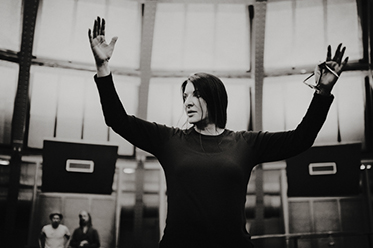 I’ve never been fond of gatekeepers. Airport immigration officers. Bank loan managers. The great artist Marina Abramovic is certainly a gatekeeper of the performance art world. But, like everyone else attending the media launch on Tuesday of the iconic performance artist’s new residency event at Sydney’s Walsh Bay, I could not resist her charisma.
I’ve never been fond of gatekeepers. Airport immigration officers. Bank loan managers. The great artist Marina Abramovic is certainly a gatekeeper of the performance art world. But, like everyone else attending the media launch on Tuesday of the iconic performance artist’s new residency event at Sydney’s Walsh Bay, I could not resist her charisma.
The artist is present
She is tall and regal and speaks with a strong accent. Her dark hair is parted down the middle and plaited to one side. She floats across the uneven pier boards, in a long flowing coat. She clutches the hand of novelist David Malouf, who is a regular attendee of art patron John Kaldor’s exclusive art events.
Just as easily, Abramovic clutches the hand of an art writer or an “experience facilitator” (I promise I will explain). In other words, she seems to enjoy engaging with the general public. The question remains as to whether this kind of re-performance artwork is a sincere act or an act of guileful opportunism or even an illegitimate encounter.
First, what is Kaldor Project 30’s Marina Abramovic: In Residence? Well, if you don’t like holding hands with strangers and if you are embarrassed by audience participation and if you find cult figures a bit creepy, you might not enjoy the event.
Abramovic has chosen 12 highly talented Australian artists to live in the upstairs space of Pier 2/3 Walsh Bay to participate in intensive workshops with the great artist. Meanwhile, more than 40 facilitators (black-clad artists and students) lead the general public, all wearing mandatory headphones to muffle out sounds, around a series of participatory performances on the ground floor.
The media delegates were denied possession of phones and bags, and led by the hand of a calm facilitator to conduct their new buzzword: “live experience performativity”.
This comprised slow motion walking. Here the participants were encouraged to walk from one end of the pier to the other, astronaut-style. What seemed like an interminable distance was soon altered. The muted squawks of the seagulls, the shafts of sunlight cast through the old sea-hardy wooden walls and the gentle rhythm of others moving at snail speed became a calming experience.
There was the sorting room where the art-writing humans sat at desks and sorted rice from lentils and kept a score sheet. Repetitive tasks can be relaxing; I get the same bliss-bomb cheek-flush from colouring-in with my daughter.
Then there was the main stage, a low-rise platform in the shape of a cross, where audience members were encouraged to climb up and stand with eyes shut. Abramovic said, “The platform is energetic”.
There were the colour charts: chairs facing swatches in red, yellow and blue. The effect of colour on mood might have a transforming effect but I was much too busy performing the best experience of all: the staring contest, aka The Artist is Present, which was her exhibition at MOMA in 2010.
The progress of an artist
On Tuesday Abramovic made the following unexpectedly humorous observation: People keep saying, “Oh Marina, what happened to the good old days when you used to cut yourself?“ Well, I say it’s easy to cut yourself. You cut, you heal. This endurance work, sitting opposite people for three months, now this really is hell.
Abramovic is right. The durational, seated eye-contact engagement really is hell. But it’s also revealing and emotional. I was led to a seat opposite another art writer where we sat together for more than 30 minutes, eyes locked.
My thoughts ranged from her excellent cheekbones, to her habit of widening her eyes. I thought of her mother and then my mother and my mothering and the ancestry of eyes. I thought of stories and tattoos, of writing tales inscribed in the earth and on the skin. I thought of the rumble of trains and the heat in bellies, of love and sensuality, of strange lives to witness, of pain and sorrow and madness, of energetic atmospheres.
I was entranced by the experience of a slowed heartbeat and fewer breaths. I barely needed any breath. Abramovic is right. Abramovic explained these exercises or methods are intended as tools. They are meant to transform participant experience. She said: Long durational work is the key to experience. Our lives are so fast. Art must slow us down. These exercises are based on repetition. Something small, a ritual, eventually becomes a universe.
A sceptic by nature, but with a secret penchant for superstition and a love for stories, I came away from the event as a convert. The facilitators looked like cult-members in their black garb and slow steps. But, hallelujah, I believe.
What do I believe? I believe there are great community experiences to be shared with others in contemporary art. Art is alive and energetic and performative in Sydney. We all need to be reminded – especially Monsieur Brandis – of the value of live experience performativity and the worth of experimental social-wellbeing events that teach us there are other stories to tell and new aesthetic experiences to be had. Before the media conference ended, Abramovic said, “Art is a service to society”.
Marina Abramovic’s residency with Kaldor Public Art Projects runs until Sunday 5 July 2015. Details here.
The mystical stillness of Marina Abramovic in Sydney
Prudence Gibson is Art writer and Tutor, UNSW at UNSW Australia.
This article was originally published on The Conversation.
Image: Portrait of Marina Abramovic, © Rahi Rezvani, Paris 2013.
